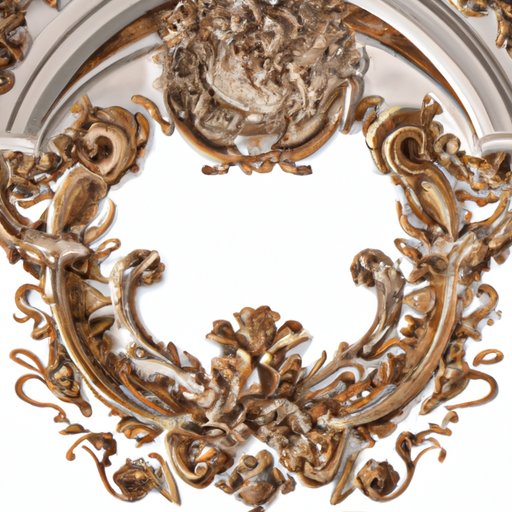Introduction
Rococo and Baroque art are two distinct and influential artistic styles that emerged during the 17th and 18th centuries, respectively. Although they share some similarities, there are also many differences between the two. This article will explore how these two styles differ in terms of their visual aesthetics, historical contexts, themes, and techniques, as well as their influence on modern art movements.

Comparing the Visual Aesthetics of Rococo and Baroque Art
One of the most obvious differences between Rococo and Baroque art is their color palette. While Baroque paintings tend to be darker and more somber, with earthy tones and muted colors, Rococo paintings are characterized by bright, vibrant colors and pastels. Similarly, the use of light differs greatly between the two styles. Baroque paintings often employ dramatic contrasts between light and dark, while Rococo paintings typically have a softer, more diffused lighting.
Another important distinction between the two styles is their approach to symmetry and balance. Baroque paintings often feature a strong sense of symmetry and structure, while Rococo paintings are more asymmetrical and whimsical. The composition of each style also reflects this difference, with Baroque paintings featuring strong diagonal lines and Rococo paintings relying heavily on curved lines.
Analyzing the Historical Contexts of Rococo and Baroque Painting
In order to understand the differences between Rococo and Baroque art, it is important to consider their respective historical contexts. Rococo art emerged in 18th century Europe, during a period known as the Enlightenment. This era was characterized by a focus on reason and science, as well as a new emphasis on pleasure and leisure. As such, Rococo art often featured lighthearted and playful themes, as well as ornate and decorative elements.
Baroque art, on the other hand, originated in 17th century Europe, a period marked by religious and political upheaval. Accordingly, Baroque paintings were often used to convey religious or political messages, depicting scenes from the Bible or classical mythology. They were also used to glorify rulers and powerful figures, with the aim of creating a sense of awe and reverence.

Examining the Themes in Rococo and Baroque Painting
The themes depicted in Rococo and Baroque paintings can also be quite different. Rococo art often focuses on pleasure, leisure, and decadence, with depictions of lavish parties, romantic scenes, and sensual nudes. In contrast, Baroque paintings often feature religious or political themes, such as scenes from the Bible or classical mythology, portraits of rulers, and allegorical works.
Contrasting the Techniques Used in Rococo and Baroque Painting
Finally, the techniques used in Rococo and Baroque painting can help to further distinguish the two styles. Rococo paintings are generally characterized by fluid lines and intricate ornamentation, while Baroque paintings often feature dramatic compositions and tenebrism, which is the use of extreme contrasts of light and dark. Additionally, Baroque paintings often contain hidden symbols and messages, while Rococo paintings are more concerned with surface beauty.

Exploring the Meaning Behind Rococo and Baroque Art
When examining Rococo and Baroque paintings, it is important to consider what these works represent and how they reflect the ideas of their time. Rococo art can be seen as a celebration of the Age of Reason and its emphasis on pleasure, leisure, and luxury. On the other hand, Baroque art was often used to make religious or political statements, or to glorify rulers and powerful figures.
Investigating the Impact of Rococo and Baroque Art on Modern Art Movements
The influence of Rococo and Baroque art can be seen in a variety of modern art movements. For example, the ornate and decorative elements of Rococo art can be seen in Art Nouveau, while the dramatic lighting and tenebrism of Baroque art can be found in Expressionism. Additionally, both styles have had a lasting impact on contemporary art, with many artists finding inspiration in their themes and techniques.
Conclusion
In conclusion, Rococo and Baroque art differ significantly in terms of their visual aesthetics, historical contexts, themes, and techniques. However, they share some similarities, such as their influence on modern art movements. By understanding the differences between these two styles, we can gain insights into the ideas and values of their respective eras.
(Note: Is this article not meeting your expectations? Do you have knowledge or insights to share? Unlock new opportunities and expand your reach by joining our authors team. Click Registration to join us and share your expertise with our readers.)
